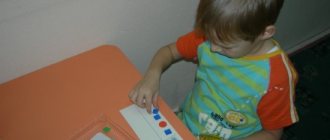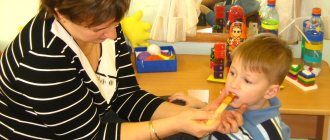Phonemic speech disorder refers to a child's inability to identify the correct sounds by ear.
This problem manifests itself in the fact that sounds are pronounced incorrectly, are deafened or voiced, are replaced from hard to soft, are skipped or rearranged in words. At the same time, the child does not notice the mistakes made, since he simply “does not hear” the difference. Phonetic-phonemic underdevelopment of speech occurs due to phonemic hearing impairment. That is, the child not only pronounces sounds incorrectly, but also cannot determine by ear which sound is needed in a particular case.
FFND can manifest itself to varying degrees:
- Defective sound pronunciation occurs due to difficulties with the analysis of phonemes.
- The child pronounces all sounds correctly, but has difficulties with phonemic hearing.
- The child's speech has problems determining the correct sound order in words.
How does phonetic-phonemic underdevelopment of speech manifest itself?
The most characteristic signs of the presence of FFND, which parents should pay attention to, may be:
- Replacing “complex” sounds in speech with easier ones to pronounce. For example, the sound P can become the sound L, hissing and whistling sounds can be replaced by explosive sounds (Ш or Ж on T or D, both hard and soft).
- Mixing sounds. That is, a child can separately pronounce phonemes that are difficult for him, but in words and sentences they are still replaced by simpler ones.
- One sound can even replace a couple or more. For example, one explosive sound can replace several hissing and whistling sounds at once.
- With correct pronunciation, a child may not be able to distinguish sounds belonging to different types by ear. In this case, the problem of phonemic violation comes to the fore.
FFNR: concept, signs
When diagnosing, it is important to distinguish the defect in question from other speech therapy disorders.
According to the etiological factor, FFNR is distinguished:
- congenital (genetic predisposition, complicated pregnancy and childbirth);
- acquired (traumatic brain injuries, pedagogical neglect, psychological problems).
The classification according to the severity of the defect is presented in the diagram:
This conclusion is made in the absence of mechanical damage to the organs of the articulatory apparatus, with a good vocabulary and sufficiently developed coherent speech. The results of the examination are recorded in a special document - a speech card. The dynamics of the correctional impact are also reflected here.
Why you need to see a specialist
This problem may seem insignificant to parents. After all, even in classic children's stories, we read how cute children lisp or grumble, while possessing excellent intellectual abilities.
However, experts warn that such a violation can turn into a problem when studying at school. FFNR means, first of all, the fact that the child is not able to analyze and determine the desired sound. This entails problems with spelling, as well as dyslexia and dysgraphia. In addition, incorrect pronunciation can last a lifetime, because the child “does not see or hear” his mistake.
Concept and characteristics of FFN, classification
What is this - phonetic-phonemic underdevelopment of speech? FFN (or the abbreviation FFNR) refers to the insufficient development of a child’s pronunciation ability due to impaired perception or incorrect pronunciation of the minimum part of a word (phoneme - a component of a word). In our country, the number of children with FFN is 20-25%. The most famous authors who described in detail the FPN and the features of phonetics are R. E. Levina, N. A. Nikashina, A. V. Yastrebova. They included an incompletely formed articulatory function, as well as a disturbance in the perception of sounds, as the mechanisms of pathogenesis.
Causes and factors for the occurrence of FFN:
- Head injuries during childbirth.
- Lack of activities with the child.
- Stressful situations.
- Problems of a psychological nature.
Comparison of phonetic and phonemic defect
In speech therapy, FFND is divided into 2 concepts: phonetic and phonemic impairment of speech function. According to the comparative characteristics, these 2 options have significant differences. A phonetic pronunciation defect is characterized by distorted sound reproduction. This condition can be explained using the example of a patient who is unable to pronounce the sound “R” (the child burrs). The patient knows that he is producing the sound incorrectly, but does not mix it with others. This condition changes the oral form of speech, but the child writes all the letters in words correctly.
A phonemic change in speech function involves the complete replacement of a particular sound by another (“lodina” instead of “mole”). The child does not see the difference between the sounds (in this case, “L” and “R”). The disorder may persist in the patient until 5 years of age or older. With phonemic pathology, a child’s speech function and spelling may be impaired.
Classification of FFN by severity:
- Mild - the child is not able to distinguish (hear) in speech only defective sounds that he himself cannot pronounce correctly. The child distinguishes other sounds well.
- Average - the patient cannot distinguish a large number of sounds in speech that belong to different phonetic groups, while the child’s oral speech function is formed normally.
- Severe - severe impairment of recognition and reproduction of sounds in words (SSD - severe speech impairment), the patient cannot identify sounds, as well as reproduce their sequence.
Who should I contact?
If parents suspect that their child has speech problems, they should visit a speech therapist as soon as possible. The specialist will conduct a detailed examination and conclude whether there is a need for corrective measures.
How the examination is carried out:
- By asking the child questions or offering to perform this or that exercise, the speech therapist will determine “difficult” phonemes to pronounce. You will need to work on the correct production of sounds.
- The next step is to find out whether the child has difficulties with auditory perception of sounds. Certain types of tests can confidently identify this disorder. The speech therapist will ask you to name the first or last sound in the name of the object shown in the picture, indicate the sequence of sounds (for older preschoolers), find from different objects those that begin with a certain sound, etc.
Taking into account all possible examination indicators, a specialist corrective action plan is prescribed. It is important to solve the problem before starting school so that the child learns successfully.
Stages of formation of phonemic processes in teaching literacy to children with severe speech impairments
Tatiana Botvineva
Stages of formation of phonemic processes in teaching literacy to children with severe speech impairments
Correct speech is one of the indicators of a child’s readiness for school , the key to successful literacy and reading . Written speech is formed on the basis of oral , and children with severe speech impairments , characterized by insufficient development of phonemic processes , are potential dysgraphics and dyslexics.
The theory and practice of speech therapy work convincingly prove that developed phonemic processes are an important factor in the successful development of the speech system as a whole.
Effective and permanent correction of pronunciation defects (sound pronunciation, syllabic structure of words)
may be possible only with the advanced
formation of phonemic perception .
The ability to hear each individual sound in a word, to clearly separate it from the next one, to know what sounds the word consists of, that is, the ability to analyze the sound composition of a word, is the most important prerequisite for proper literacy learning .
phonemic processes include . Phonemic processes include :
- phonemic hearing - the ability to auditory perception of speech , phonemes . Phonemic hearing is of utmost importance for mastering the sound side of a language; on its basis, phonemic perception is formed .
- phonemic perception - the process of listening to certain phonemes , regardless of positional overtones. The physiological basis is complex conditioned reflex connections. In the structure of phonemic perception, phonemic analysis and synthesis . Phonemic analysis is the mental process of decomposing a whole into its component parts (sentence - words - syllables - sounds)
or mental isolation of individual
phonemes , establishing relationships of a part to the whole, to other parts of the whole and its constituent elements. Phonemic synthesis is the mental process of combining parts into a whole. The process is opposite to analysis, but they are closely interrelated and inseparable from each other.
- phonemic representations - sound images of phonemes perceived by a person earlier and at the moment not acting on his senses. The physiological basis is the result of the activity of not one, but two or more analyzers.
I. Preparatory stage
Work on the formation of phonemic perception at the very beginning is carried out on the material of non-speech sounds. Through special games and exercises, children develop the ability to recognize and distinguish non-speech sounds.
Children should learn to distinguish the pitch, strength and timbre of their voice through games, listening to the same speech sounds, sound combinations, and words.
Then children learn to distinguish words that are similar in sound composition. Later, they learn to distinguish syllables and then phonemes of their native language .
1. Development of auditory perception
Game "Silence"
,
“Guessing Game”
,
“High - Low”
,
“Quiet-Loud”
,
“Draw a Sound”
,
“Uphill, Downhill”
,
“Alyonushka-revushka”
,
“Echo”
.
2. Development of auditory memory
V. G. Kazakov and L. L. Kondratieva (2001)
highlight the following general rules
for the formation of children's memory :
“Memory develops in activities that require the constant manifestation of operational and long-term memory. Only by loading and using memory, remembering and reproducing previously received information can one develop memory.
The more attentive, active and independent the child’s activity, the better the memory necessary for this activity develops. Activating a child’s activity and ensuring its success is the most effective way to develop his memory.
Things that are directly related to the needs of children .
It is more effective to remember something that is united by some thought into a logical whole. Such unification is achieved by a rational sequence of studying the presented material, where the previous one ensures the assimilation of the subsequent one, and the subsequent one strengthens the previous one in memory.
An important condition for complete and accurate memorization is the ability to carry out a semantic grouping of material - dividing it into parts, highlighting the main and essential in each part.”
Thus, based on all the above recommendations and individually selected developmental games and techniques, we can offer the following tasks for the development of auditory memory of children in this group : “Remember and say, “Remember and show”
,
“Repeat the tongue twisters”
II. Main stage
The task of this stage of work is to develop children’s skills in elementary sound analysis. This stage is divided into three blocks: Teaching simple forms of phonemic analysis , Teaching complex forms of phonemic analysis , Forming the skill of sound synthesis, Forming phonemic representations .
1. Teaching simple forms of phonemic analysis
Lotto game
Children determine the presence of a given sound in the title of the picture.
Lotto “Unusual Flowers”
Children choose pictures whose names begin with a given sound.
Lotto “What is the first sound?”
Children find a picture whose name begins with a given sound, name it, identify the first sound and cover the picture with the letter corresponding to the first sound of the word.
Game "Find the picture"
Children name the object, determine the first sound in its name, and find the corresponding letter. Then they select a picture whose name begins with the same sound.
Game "Traffic Light"
Children determine the place of a sound in a word (beginning, middle, end)
.
2. Teaching complex forms of phonemic analysis
Sequence of presentation of speech material:
- words with two vowels (au, ua)
;
- monosyllabic words from the reverse (um, oh, us, direct open (na, mu, yes, closed syllable (house, poppy, nose, bow)
;
- two-syllable words made of two open syllables (mother, frame, Masha, roses)
;
- two-syllable words made of open and closed syllables (sofa, sugar, oak, etc.)
;
- two-syllable words with a consonant cluster at the junction of syllables (lamp, brand, shelf, etc.)
- monosyllabic words with a consonant cluster at the beginning of the word (rook, doctor, table, etc.)
- monosyllabic words with a consonant cluster at the end of the word (wolf, tiger, regiment, etc.)
;
- two-syllable words with a combination of consonants at the beginning of the word (grass, roof, doctors, etc.)
- two-syllable words with a combination of consonants at the beginning and middle of the word (flowerbed, lid)
;
- three-syllable words (locomotive, ditch, cabbage, etc.)
.
To do this, it is suggested to use the following games:
Dice game
Children throw a cube, their task is to come up with a word based on the number of dots on the dropped side of the cube.
Game “What sound fell out of the word?”
Children listen to the words and call them “dropped out”
sound
(mole - cat, lamp - paw, file - saw)
.
Game "Chamomile"
Children are given the task of choosing petals with objects depicted on them, the names of which consist of a different number of sounds. (as instructed by the teacher)
.
Game "Fill the Lane"
The child is presented with a picture and a graphic diagram of a certain number of cells according to the number of sounds in a given word. As sounds are identified, the child fills in the diagram with chips. This results in a model of the sound structure of a word. Initially, monosyllabic words are given for analysis, such as: poppy, cat, house, onion.
The following tasks are also used:
- Choose words with a certain number of sounds.
— Select pictures whose titles will indicate the number of sounds.
- Based on the plot picture, select words with a certain number of sounds.
There are a lot of tasks in the literature aimed at developing complex forms of phonemic analysis ; we will not dwell on them.
The processed speech material should be actively used when composing sentences or pairs of sentences, including words contrasted on a phonemic basis .
Tom entered the house. Zakhar eats sugar.
Mom is cooking. Mom's cooking.
Sveta saw daddy. Sveta saw a butterfly.
Sveta saw a butterfly. Sveta saw a butterfly.
3. Formation of sound synthesis skills
When carrying out work in this direction, it is necessary to remember that it is easier for children to analyze than to synthesize sounds.
For this purpose, you can use the following tasks:
- Synthesize vowel sounds into babbling words (au, ua, ia)
.
- Synthesis of monosyllabic words (soup, cat, name the number of sounds in a word.
— Compose words from a given sequence of sounds.
— Arrange the pictures under the corresponding graphic diagrams, which indicate only vowel letters: A__ __A, __O __A, __U __A, etc. Pictures are offered depicting objects with 2 syllables: trigger, slide, boat, aster, porridge, fly , windows, duck, moon, cat, mother, frame, puddle, spoon, paw.
- Finish the word: pomi., vonog., apple., carto... etc.
- Identify a word or sentence pronounced syllable by syllable. For example: children play in the garden.
- Compose a word from syllables given in disorder.
Ko-lo-mo - milk
Sha-ka - porridge
Ba-shu - fur coat
La-ko - Kolya, etc.
Such tasks are very variable; at each lesson you can give the same exercises, but use different speech material. This is due to the fact that children like repetitive tasks, they look forward to them, and they know the name of the task.
4. Formation of phonemic representations
This stage of correctional work involves the formation of the action of phonemic analysis in the mental plane. At this stage, children determine the number, sequence and location of sounds without naming words, based on ideas.
The following tasks are offered.
- Come up with a word with 3 sounds.
- Clap your hands, walk as many steps as there are sounds in the words: house, porridge, lemon.
— Match the picture to the sound scheme S G S S G S G S S G S
- Find the animals, who hid in which house S G S S G S G S S G S L E V L I S A S L O N
- Remember the words to the graphic diagram without relying on the picture.
S G S S G S G S S G S
— Construct graphic diagrams indicating vowel and consonant sounds with chips.
— Game situation: craftsmen built a sound house of 3 rooms. Which of the animals (fox, wolf, lion, deer)
can live in it.
— Completion of sentences: the speech therapist names the first 2 words, the child finishes the third, fourth, etc.
- Listen to the words and make a sentence out of them.
These exercises allow you to consistently, in accordance with the principle of the gradual formation of mental actions , consolidate the skills of sound analysis and synthesis in the mental plane, that is, without relying on specific perceptions - chips and pictures.
Of course, to achieve a positive result, it is necessary to create a unified correctional and educational space, when a team of like-minded people works on speech (speech therapist - parent - educators, each of whom is interested in the success of the work and is constantly in interaction with the others.
How does a speech therapist work with FFND?
Corrective action tactics are based on an examination of the child. The work can be carried out both in group classes and individually. In the latter case, the lessons will be more effective, since they allow you to give maximum attention to the child and take into account his difficulties and problems in the plans. Speech therapy classes include:
- Exercises aimed at correct pronunciation of sounds.
- Game speech therapy gymnastics.
- Auditory attention training.
- Work to improve sound perception, teaching the basics of phonetic analysis and the correct identification of phonemes in a word.
- Exercises to conduct sound and syllabic analysis, which ensures the successful development of literate written speech.
All classes are conducted in a playful way. The child should feel comfortable during lessons, getting ready for work. Corrective measures must be comprehensive. In addition to the speech therapist, parents should also take a significant part in the work. A unified approach to carrying out correctional work, completing the speech therapist’s “homework”, supporting the child and maximum assistance provided during the period of correction of violations will help him cope with the problem in a short time.
Diagnostic measures
If symptoms of FFN are detected, parents should contact a speech therapist. There are speech therapists in every school and kindergarten. Speech therapy classes can also be attended in specialized centers.
The most popular treatment centers for FFND and general speech underdevelopment (GSD) are:
- Clinic of speech pathology in St. Petersburg.
- Center for Speech Pathology and Neurorehabilitation of Shklovsky V.M. (Moscow).
- St. Petersburg Research Institute of Ear, Throat, Nose and Speech.
- Anna Belik Speech Correction Center (St. Petersburg).
Diagnosis of FFN includes the collection of anamnestic data to determine the possible cause, as well as speech therapy examination. The doctor looks at the patient’s card or extracts from it. The specialist asks the mother about the course of pregnancy, childbirth, the mental situation in the house, the presence of functional pathologies of the brain, as well as biological and physiological changes in the body. For a doctor, the presence of mental trauma and chronic stress, which often lead to impaired speech function, is of great importance. On the eve of the first visit to speech therapy classes, the child should be examined by a neurologist or otolaryngologist to exclude mental disorders, organic brain lesions, consequences of head injuries, and diseases of the speech apparatus.
To register, the speech therapist creates a speech card for the child. In it, he describes the state of auditory function, the presence or absence of brain diseases. The card also includes general health status, vaccinations performed, and previous diseases.
The specialist examines the articulation apparatus, assesses the condition of the vocal cords and respiratory function necessary for normal speech. He does several pronunciation tests to determine which sounds the patient cannot produce. This data must be entered into the card.
The speech therapist evaluates vocabulary, the presence of substitutions and displacements of sounds, and changes in the structure of the word. The ability to construct sentences is also assessed. The doctor must pay attention to breathing while reproducing words and sentences.
If the child can write, then the speech therapist looks at the state of written speech. The doctor notes the presence of grammatical errors when writing words and replacing letters. After a complete examination, the doctor writes a conclusion and also draws up a lesson plan for correcting speech function.
How quickly can you fix the FFNR problem?
You should not expect instant results from classes. After all, the child, together with a speech therapist, will have to go a long way from preparing the speech apparatus to establish correct sound pronunciation to automating sounds in speech, developing stable phonetic hearing and the ability to conduct phonemic analysis. This is why it is important to start work as early as possible. As a rule, this problem can be identified at 4-5 years of age. This means that before entering school, the child will cope with all difficulties and will be able to become a successful student.
Date of publication: 06/27/2016. Last modified: 05/09/2018.
What does it look like?
So, FFNP in speech therapy is, first of all, the immaturity of the processes of recognition and pronunciation of phonemes of parts of speech, which is necessary for a correct understanding of the meaning of what is being said. That is, we are talking about underdevelopment of phonemic hearing, not physiological. At the same time, the child also has pronunciation defects. What happens to the child’s speech? In different cases, different defects are possible.
- When pronounced, sounds are distorted (for example, instead of “sh” there is a sound halfway between “v” and “f”).
- The sounds are replaced with ones that are more easily reproduced for the child (for example, instead of all whistling ones, he pronounces the sound “t” or “p”, instead of hissing ones - “s”).
- Often there is no difference between hard and soft sounds (says “s” instead of “s”, “cha” instead of “ta”, etc.), the child “lisps”.
- There is no difference between voiced and unvoiced sounds when heard or pronounced (“tom” instead of “house”, “folder” instead of “grandmother”).
- The child confuses sonorant sounds - “l”, “m”, “n”, “r”. Moreover, in their speech such children sometimes replace not only “r” with “l” (rak-lak), but also vice versa (“moroko”, “rapti”).
- The same can happen with whistling and hissing sounds.
- Sometimes children with FFND may experience variable pronunciation of sounds (in some cases a sound or syllable is pronounced correctly, in others it is distorted or disappears altogether).
In the speech of such children, neighboring sounds may be mixed, syllables may be blurred, and sometimes the grammatical structure of sentences may be disrupted (times, numbers, endings are confused).
In advanced cases, the speech of a child with FFDD is quite difficult to understand; it becomes “stringy,” illegible, incoherent, and sometimes illogical. It is clear that such a student will certainly have problems with writing, spelling, and therefore with academic performance. But psychological complexes caused by difficulties in communicating with others, especially with peers, can be much more serious. Therefore, such problems need to be corrected as early as possible (preferably before school).
Correction of speech dysfunction
After a complete examination and assessment of speech, the speech therapist draws up a lesson plan and writes recommendations for a kindergarten or school on how to carry out correction. He can also independently treat FFND by prescribing a set of individual sessions with the patient (home sessions are possible). During therapy, the speech therapist must correct errors in spoken words, develop phonetics skills, and also prepare the patient for writing and reading.
Classes with a speech therapist can be group or individual. Group classes involve working with several children. In individual lessons, the child studies alone. The advantage of group classes is that children can learn to talk to each other through dialogue, skits and other types of communication. At the same time, they compare sounds, learn to find mistakes from each other, and construct sentences correctly.
If a preschooler has a severe form of speech impairment, he can be sent to a special speech therapy kindergarten for classes. Children with speech impairments are gathered here, so classes are aimed at improving speech, reading and writing. Children are enrolled in the group of such a kindergarten from the age of 5-6 years. The duration of correction is 10 months.
Goals of FFN therapy:
- The patient masters correct pronunciation and articulation.
- Formed analysis and synthesis of speech.
- Enrichment of vocabulary.
- The appearance of coherent speech.
- Correct composition of phrases and sentences.
- Teaching correct writing and reading.
- Improved attention and memory.
To conduct classes, the speech therapist uses gymnastic exercises to develop articulation, drawings, toys, games, cards with written syllables and words, and books. It is very important to create a calm and comfortable environment during practical classes. It helps reduce the child’s excitability and improves contact between the child and the teacher. To reinforce the material, the speech therapist gives tasks that need to be done at home.
Along with speech therapy and pedagogical classes, the child needs the help of a psychologist. A psychologist will help you cope with stressful situations and family problems. It also helps develop memory, thinking, and fine motor skills. To do this, they carry out memory training (cards with pictures, tables), art therapy, games with small objects, using ice to stimulate blood circulation in the hands and other techniques.
It is recommended that correction be carried out before entering school so that speech disorders do not disrupt the patient’s mental health or interfere with learning.






